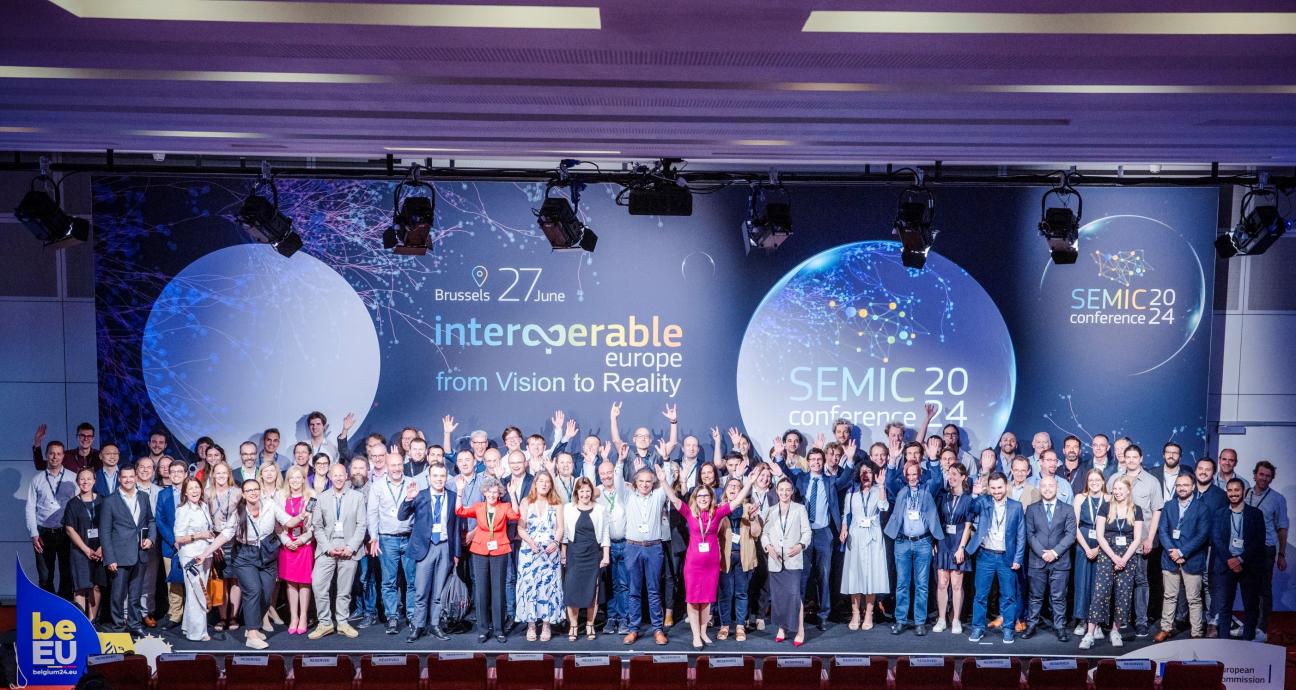SEMIC 2024, the Semantic Interoperability Conference, organised by the European Commission in collaboration with the Belgian Presidency of the Council of the European Union, achieved a new record in the number of participants, with 480 on site visitors and 1188 unique followers online.
The pre-conference workshops also attracted many experts in the field of semantics and digital government with a number of 223 on-site attendances and at least 459 unique followers online.
The Act as an unparalleled opportunity
With the Interoperable Europe Act that entered into force in the Spring of 2024, the goal of this year’s edition was to transform the vision defined by the Act into concrete implementation.
In a video-message to the audience, EU Commissioner for Budget and Administration Johannes Hahn declared that the entrance into force of the Interoperable Europe Act is a cause of celebration:
“A new reality where cross-border interoperability of public services becomes a legal routine, where cooperation among Member States turns into a regular co-working practice. We have a jointly owned governance structure to move forward the digital government transformation in Europe."
According to Hahn, this is an unparalleled opportunity in building a more efficient, competitive, yet inclusive Europe through interoperability and digital government.
Flemish Minister-President Jan Jambon stated that he firmly believes that Europe can be on top of the world in the data economy if we continue to work together. "Flanders is committed to the Interoperable Europe Act in its journey to create a true interoperable Europe with standards the entire EU can be proud of."
For this reason, Jambon stressed the importance of standards and interoperability efforts to create successful European dataspaces, as the basis of trustworthy AI use in government, taking the Flemish OSLO initiative as a good example of achieving standardisation for the exchange of data.
Markus Richter, the German State Secretary in the Federal Ministry of the Interior and Community and Federal Government Commissioner for Information Technology, also welcomed more cooperation on interoperability in the EU, among others via the newly Interoperable Europe Board. "Interoperability is much more on the forefront in Germany due to the technological changes and the threats we are facing.” More specifically Richter called upon the EU to work closer together on software solutions, infrastructure, data architecture, Innovation, education on digital skills.
Concerning innovation, the Director of Digital Services at DIGIT Natalia Aristimuño Pérez emphasized that working together on innovation in the public sector has the great advantage of spreading risks when something can go wrong. “But we shouldn't reinvent the wheel each time, the Director continued. “We can exchange and reuse many solutions we already have!"
User centricity as an important pillar
Slovenian Minister of Digital Transformation Emilija Stojmenova Duh gave an overview of the many activities in ensuring interoperability of services in her country. She emphasized that digital services need to be interoperable, personalised and focused on the user's experience. “We must always focus on the user and improve the quality of his life with services. In order for citizens to be able to use digital services, they must have developed digital skills. The civil servants who develop the services must also be digitally qualified.”
Hilde Hardeman, the Director-General of the Publications Office, subscribed to this vision. ‘We really need to think, for whom are we doing that? How will it be used in real, practical life?' She also emphasised trust of the user in services is much more important than is often thought. "Don't underestimate the consequences if we make plans on sharing data without sufficient cybersecurity. We will have big problems if something goes wrong."
Hardeman also coined the phrase “the European Union is an interoperability project in itself”. A line that resonated very well with the head of the DG DIGIT Unit for Interoperability and Digital Government, Leontina Sandu. “We will put it on our Interoperable Europe website”, Sandu playfully promised.
A growing community for a more connected Europe
Next to the selection of messages from high-level panels above, SEMIC 2024 drew numerous public sector leaders, academics, political experts, and business representatives to the conference room. For two days, these speakers generated countless inspiring ideas on the central theme of implementing the vision of the Act during high-level panels, workshops and sessions, all of which had different angles.
Summarising all these ideas in a news article would be practically impossible. Nevertheless, the enormity of ideas also indicates how strong the community of available stakeholders to improve semantic interoperability has grown over the years since the first SEMIC conference started.
To Maximilian Strotmann, Cabinet Member of EU Commissioner Johannes Hahn, the dots and branches in the SEMIC 2024 visual identity embody this growth. “They symbolise the continuous growth of creative interoperability cooperation that is happening above and under the EU radar.”
This is also a conclusion shared by the Director-General for Informatics Veronica Gaffey. “The conference has become a critical venue for sharing knowledge, fostering collaborations, and driving innovation in public sector digital services”, Gaffey said. “We count on you as our growing community to continue to improve interoperability and with that, digital public services for a more connected, more inclusive, more competitive Europe. We count on your expertise and active contribution when implementing the Act and making its vision a reality.”
While more visual materials on SEMIC 2024 will be published later, a selection of pictures of the event can already be seen below. More messages and insights that were shared during SEMIC 2024 can be found via our social media channels (X and LinkedIn).
Under the Danish Presidency of the Council of the European Union, the SEMIC conference is projected to return to Kopenhagen in 2025.

